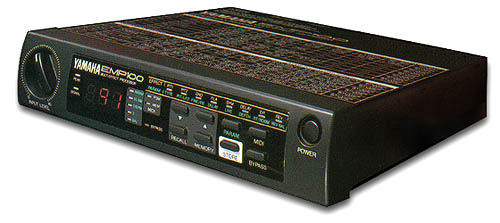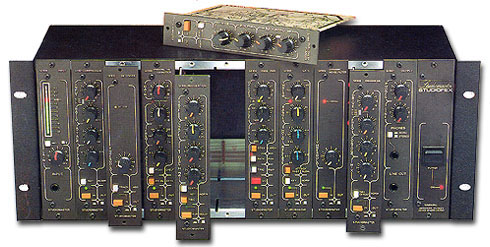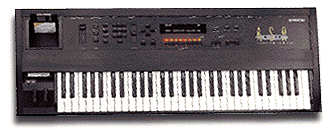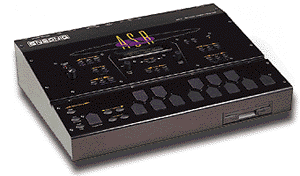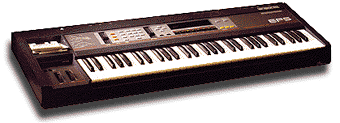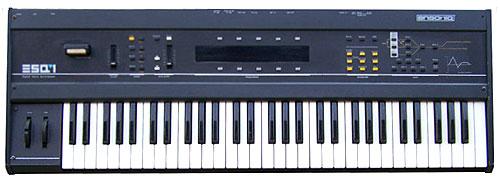Ensoniq dp4

Category: Products / fx & processors / multi-fx
Added: 21-Mar-06 | Author: admin
New price: discontinued | S/H price: 100-200 GBP
Company Link: ENSONIQ Archive
Company Link: ENSONIQ USER DATABASE (E.
Ensoniq dp4
The Ensoniq DP4 is quite an amazing litle unit offering 4 simultaneous channels of FX processing.DP-4 Specifications
Memory
54 Algorithms: 1 Unit (50) 2 Unit (3) 4 Unit (1) 400 Presets (200 ROM, 200 RAM)
Maximum single delay time (no regeneration) = 6.6 seconds 20 Song memories for chaining any 5 Presets together for performance situations
Input/Outputs
A/D - D/A conversion: 16 bit linear Input Level: -34.6 dBV to +22 dBu Frequency Response: 2 Hz-18 kHz Dynamic Range: 96 dB Signal - Noise ratio: -90 dB "A" weighted
MIDI
Responds to 6 MIDI channels at the same time
- Each Unit can be assigned its own MIDI channel for receiving program changes, Bypass Killstatus changes, MIDI volume control
- A separate MIDI channel can be assigned for receiving effect modulation/controller messages
- A separate channel can be assigned to receive Config Preset program changes
Separate program change map tables per Unit
Responds to Controllers #000 - #127 Pitch bend wheel Note number Velocity Pressure (channel/mono or key/polyphonic) Control voltage input Up to 4 Foot switches (2 x SW-10)
From http://www.stanford.edu/~dattorro/DP4.htm:
There were four ESP DSP chips* designed into this unit, which means four distinct channels of processing. Each processor was a parallel processor capable of about 300 VLIW instructions per sample period. That necessitated highly efficient real-time programming. The original CPU design was by Bill Mauchly and Steve Hoge. Mauchly, I, and Dave Andreas later redesigned the ESP from scratch for which we received a patent. Mike Arnao wrote a beautiful symbolic assembler; he made programming the unit a real joy. The programming language we developed for the unit is a model of elegance and power. *(Thanks to Matthew Craig and Charles Duffy of Paris Users Group for preserving all the ESP and ESP2 documentation, source code, and assembler. ESP2 chip fabrication data was preserved by David Andreas of Silicon Labs and Alan K. Smith of Aviom Inc.)
Joe Bryan wrote the original Leslie rotating speaker simulator by physical modeling. The effect is striking, especially on headphones. I later developed the distortion algorithms for it to get that Hammond B3 sound. Except for the Delays and the Vocal Remover, I designed all the algorithms for this unit, listed below:
The strength of this unit were its reverberators, vocoder design (used to make talk nearly anything that makes sound; e.g. talking wind or waterfall), speaker emulation, nonlinear (chaotic) distortion for harmonic enhancement (a van der Pol oscillator), and crystal clear choruses employing allpass interpolation: http://www.stanford.edu/~dattorro/EffectDesignPart2.pdf
Tom Metcalf and John Senior and I spent an enormous amount of time developing the algorithms for guitar distortion. It remains utterly astounding how discerning rock guitarist are regarding distortion. It is reminiscent of violinistsí discernment of tone quality in very old wooden instruments. Hence the time we spent. About 15,000 of these units were shipped since its introduction in 1992.
Product Manuals or Files
Product Resources
More choices in this product category from other manufacturers:
Category: Products / fx & processors / multi-fx
User Comments
THERE ARE NO COMMENTS POSTED FOR THIS PRODUCTBe first to add a comment - what's the product like in real life?...
'Ensoniq dp4'
Looking for the manual? - Check this page above under the heading: 'Product manual or files' - We might have it!
Note: To cut down on spammers, cookies must be enabled to post comments to this page.
Looking for the manual? - Check this page above under the heading: 'Product manual or files' - We might have it!
[back to top]
Total stars: 5 | Total votes: 1
6 other
products from
Ensoniq
Thomann deals



